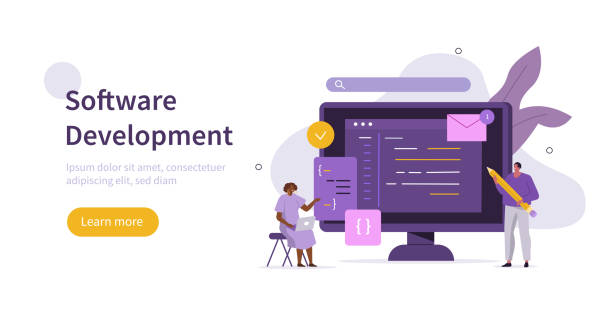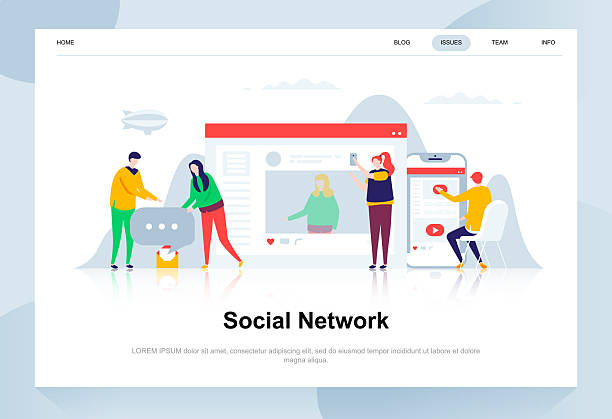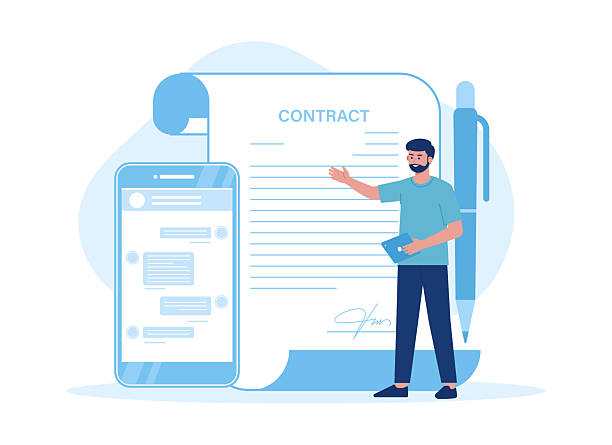Introduction and Importance of Secure Website Design

In the current digital age, where most businesses and communications have moved online, #Secure_Website_Design is no longer an option, but a vital necessity.
Website security, especially against ever-increasing cyber threats, plays a key role in maintaining user trust and the sustainability of online activities.
An insecure website can not only lead to the theft of sensitive user information but also severely tarnish a brand’s reputation and credibility.
The importance of secure website design stems from the fact that with each passing day, cyberattacks become more complex and targeted.
From unauthorized data access to Distributed Denial of Service (DDoS) attacks that take websites offline, there is a wide range of risks that need to be protected against.
This requires adopting a comprehensive and multifaceted approach at all stages of website development and maintenance.
Necessary training in this field can help developers and business owners become familiar with the principles and best practices of web security.
Protecting the privacy and personal information of users, such as bank card details, addresses, and other sensitive data, is one of the main responsibilities of every website.
Adhering to international security standards and using modern technologies in web security is an important step towards creating a secure and reliable environment for all users.
Understanding these basic principles will be the foundation for a secure and sustainable website design.
This section, as an explanatory and educational content, helps you understand the fundamental importance of web security and why it should be given special attention from the very beginning.
Are visitors leaving your e-commerce site before making a purchase? Don’t worry anymore! With Rasaweb’s professional e-commerce website design services, solve the problem of not converting visitors into customers forever!
✅ Significant increase in conversion rate and sales
✅ Unique and engaging user experience
⚡ Contact us now for a free consultation!
Common Website Security Threats

Understanding common threats and vulnerabilities is the first step towards secure website design and protecting it.
The cyber world is full of dangers that can target websites.
One of the most common attacks is SQL Injection, where an attacker attempts to manipulate or access the website’s database by inserting malicious code into input fields.
Another widespread attack is Cross-Site Scripting (XSS), which allows an attacker to inject malicious scripts into web pages visible to other users.
This can lead to the theft of cookies, session information, and even redirecting users to fake sites.
Distributed Denial of Service (DDoS) attacks are also serious threats that take websites offline by bombarding the web server with fake traffic.
Phishing, where attackers create fake pages similar to the main website to steal user login credentials, is a dangerous social engineering tactic.
In addition, weaknesses in Session Management, incorrect server configurations, and lack of software updates are among the vulnerabilities that pave the way for attacks.
Accurate recognition of these threats and understanding how they work helps developers adopt appropriate defensive measures when designing a secure website.
This section, in a specialized and analytical manner, clarifies the nature of these attacks and emphasizes the importance of continuous vigilance so that no aspect is overlooked in the process of web security.
Basic Principles of Secure Website Design from the Beginning

Building a secure website requires adherence to specific principles from the very early stages of design and development.
Secure website design must be embedded in the developer’s mindset from the outset, rather than being added as an afterthought to the project.
The first principle is “Input Validation.”
All data received from the user, whether form fields, URL parameters, or API inputs, must be carefully checked and filtered to prevent the injection of malicious code.
Furthermore, “Output Encoding” is essential for any data displayed to the user to neutralize XSS attacks.
Applying the “Principle of Least Privilege” means that each user or process should only have access to the minimum necessary permissions to perform their tasks.
This approach minimizes the risk of vulnerabilities.
“Service Isolation” also means that each website service or module should run in a separate environment so that if one section is compromised, other parts are not affected.
Additionally, choosing frameworks and coding libraries with a good security track record and that are continuously updated is very important.
Implementing strong “Logging mechanisms” to track suspicious activities is another important principle.
These principles provide the necessary guidance and training for creating a robust infrastructure for secure website design.
Paying attention to these technical points in the initial stages of website construction establishes a strong foundation for protection against future attacks.
Below, a table of common vulnerabilities and ways to counter them is provided to offer a more comprehensive view.
| Vulnerability | Description | Security Solution |
|---|---|---|
| SQL Injection | Injecting malicious SQL code to access or modify the database. | Using Prepared Statements/Parameterized Queries. |
| Cross-Site Scripting (XSS) | Injecting malicious scripts into web pages to attack users. | Input validation and output encoding. |
| Broken Authentication | Weaknesses in authentication mechanisms (e.g., weak passwords). | Using strong passwords, MFA, and proper session management. |
| Sensitive Data Exposure | Disclosure of sensitive information (financial, personal) due to insufficient encryption or protection. | Encrypting data in transit and at rest. |
The Role of SSL/TLS in Website Security

One of the most important and visible aspects of secure website design is the use of SSL/TLS certificates.
This technology, indicated by the “HTTPS” prefix in website addresses, creates an encryption layer between the user’s browser and the website server.
The main task of SSL/TLS is to ensure confidentiality, integrity, and authentication in internet communications.
Without SSL/TLS, any data exchanged between the user and the server, including login information, credit card details, and personal messages, is sent as plain text and is visible to anyone with network access.
This provides a fertile ground for “Man-in-the-Middle” attacks and eavesdropping.
By enabling HTTPS, all data is encrypted, and only authorized senders and receivers can decrypt it.
In addition to increasing security, using HTTPS for secure website design also has other benefits.
Search engines like Google prefer websites with HTTPS in search result rankings, which helps improve SEO.
Also, many modern browsers mark websites without HTTPS as “insecure,” which can reduce user trust.
This technology is not only a specialized step towards web security but also a trust-building component for users.
Education on how to properly implement and maintain SSL/TLS certificates is an integral part of the knowledge required for any web developer.
Understanding this key aspect is of great importance in maintaining the confidentiality and integrity of data during online communications and clearly shows how a website can be made secure in terms of communication.
Does your current website build the trust that potential customers should have in your business? If the answer is no, it’s time to have your professional and impactful corporate website with Rasaweb.
✅ Fully customized design tailored to your brand identity
✅ Increased lead generation and business credibility in the eyes of customers⚡ Contact us for a free consultation!
Password Management and Strong Authentication

One of the weakest links in the secure website design chain often comes down to password management and authentication systems.
Weak, guessable, or reused passwords across multiple services open the door for attackers.
To create a strong authentication system, users must first be encouraged to choose complex and long passwords.
Implementing password policies that include minimum length, use of uppercase and lowercase letters, numbers, and special characters is essential.
More importantly, the website system should never store passwords as plain text; instead, it should use strong hashing functions along with “Salt” (a random string added to the password before hashing) for secure storage.
“Multi-Factor Authentication” (MFA) or “Two-Factor Authentication” (2FA) is the next and very crucial step towards increasing security.
MFA requires the user to provide a second authentication factor (such as a code sent to a mobile phone, fingerprint, or a hardware token) in addition to the password.
This mechanism prevents unauthorized access even if the user’s password is compromised.
The User Interface (UI) design for the authentication process should also be user-friendly yet secure.
Guiding users on choosing strong passwords and enabling MFA, is an important part of this process.
This educational and guidance content section shows how focusing on these key aspects can significantly increase the stability and strength of a secure website design and protect the most critical entry point to the website.
These measures are the cornerstone of protecting user accounts and preventing unauthorized access.
Regular Updates and Security Patches

One of the often-overlooked but vital aspects of maintaining secure website design is the regular updating of software and application of security patches.
No software is completely flawless, and developers continuously discover vulnerabilities and release security patches for them.
This includes Content Management Systems (CMS) like WordPress, Joomla, Drupal, used plugins and themes, programming frameworks, and even the server operating system hosting the website.
Failure to update regularly leaves your website vulnerable to known and public vulnerabilities (CVEs) that attackers exploit.
For example, many major cyberattacks in recent years, have exploited vulnerabilities for which patches had been released long ago, but organizations had failed to apply them.
This is news and explanatory content that highlights the importance of immediate action when faced with vulnerability reports.
A secure website design strategy must include planning for regular updates and testing them to ensure that patches do not cause any issues with website functionality.
This process may seem tedious, but it is an essential step to prevent attackers from exploiting known security holes.
Many web hosting services also provide tools to facilitate and assist with the update process.
Ultimately, ignoring updates means leaving the website’s doors open for attackers.
Careful planning and regular execution of these updates will ensure a secure and stable environment for your website and prevent significant losses in the long run.
Backup and Data Recovery

One of the most vital components of a secure website design strategy is a regular backup plan and the ability to quickly recover data after an incident.
Even with the best security practices, no website is 100% immune to attacks, human errors, or hardware failures.
In such cases, having an up-to-date and recoverable backup can make the difference between permanent business loss and a quick return to normalcy.
The backup process must include all website information: core Content Management System (CMS) files, all plugins and themes, user-uploaded files, and most importantly, the database.
The database often contains sensitive and critical website information.
Backups should be performed automatically and at specified intervals (daily, weekly, or monthly depending on the volume of changes) and stored in a secure location separate from the main server.
Storing backup copies in multiple locations (such as a cloud server and a local storage device) is also recommended.
Furthermore, merely having a backup is not enough; the ability to restore data from that backup must also be regularly tested.
This section is specialized content and guidance that emphasizes the importance of this vital element in web security.
The secure website design team must have a Disaster Recovery Plan that outlines the recovery process details, responsibilities, and timelines.
These measures not only make your website resilient against data loss but also bring peace of mind to business owners.
Below, a checklist for effective backup is provided.
| Item | Description |
|---|---|
| Backup Frequency | Daily/Weekly for high-traffic sites, Weekly/Monthly for static sites. |
| Backup Content | Core files, plugins, themes, media files, and database. |
| Storage Location | Storage in separate locations (off-site, cloud, local). |
| Recovery Test | Regular testing of the recovery process to ensure proper functionality. |
| Backup Encryption | Encrypting backup copies for greater protection of sensitive information. |
Database Security and Protection of Sensitive Information

The database is the heart of any website and contains the most valuable information, including user data, transaction records, and core site content.
Therefore, database security is a fundamental pillar of secure website design.
One of the basic principles is to use the principle of Least Privilege for database access.
This means that each user or web application should only have access to the minimum necessary permissions to perform its tasks, and general admin access should be avoided.
Furthermore, encrypting sensitive information in the database, especially financial or personal user data, is essential.
This encryption can be done at rest and in transit.
Using Prepared Statements and Parameterized Queries is the best method to prevent SQL Injection attacks, as mentioned in previous sections.
In addition, disabling unnecessary ports on the database server, as well as separating the database server from the web server on separate networks, provides additional security layers.
Continuous monitoring of database logs to identify suspicious activities or attempted intrusions is also vital.
This section provides specialized and analytical content that emphasizes the importance of protecting the database and using best practices in this area.
Secure website design will be incomplete without deep attention to database security.
Attackers are always looking for weaknesses in database systems, and protecting this critical component must be a top priority for any web development team.
Also, regularly updating the Database Management System (DBMS) to the latest version and applying its security patches is of high importance.
Are you tired of your e-commerce site having visitors but no sales? Rasaweb solves your main problem with professional e-commerce website design!
✅ Significant increase in sales with targeted design
✅ Seamless user experience for your customers
⚡ Get a free consultation!
Security Testing and Continuous Monitoring

After implementation and even throughout a website’s lifecycle, secure website design requires continuous testing and uninterrupted monitoring.
The security testing process includes several stages, among which are Penetration Testing and Vulnerability Scanning.
Vulnerability scanning, with the help of automated tools, identifies known weaknesses in the website and its infrastructure.
These scans can be run regularly and on a scheduled basis.
In contrast, penetration testing is a more manual and in-depth approach where security specialists (sometimes called “ethical hackers”) attempt to discover website weaknesses using methods similar to real attackers.
These tests can include examining business logic, social engineering, and attempting to bypass security mechanisms.
In addition to periodic tests, “continuous security monitoring” is also of high importance.
This includes monitoring server logs, network traffic, and suspicious activities on the website.
Intrusion Detection Systems (IDS) and Intrusion Prevention Systems (IPS) can help identify and block attacks in real-time.
Enabling Web Application Firewalls (WAF) can also provide another layer of protection against common web attacks.
This section provides analytical and thought-provoking content that emphasizes the importance of being proactive against threats.
Do we merely suffice with periodic tests, or do we continuously monitor our security posture? The answer to this question defines the difference between a reactive secure website design and a proactive one.
These measures allow the website to react quickly to new threats and prevent serious damage.
Cultivating Security Culture in Development Team and Users

The most important layer of defense in secure website design, beyond technical tools, revolves around fostering a security culture and raising awareness among all individuals associated with the website.
This includes the development team, website administrators, and even end-users.
Educating the development team about best practices in Secure Coding Practices, common OWASP Top 10 vulnerabilities, and the use of static and dynamic code analysis tools is of paramount importance.
Programmers should write code with a “Security by Design” mindset from the very beginning.
This section is educational and guidance content that emphasizes the importance of the human aspect of security.
Conducting workshops and regular sessions to update the team’s security knowledge can significantly increase the overall security level of the website.
On the other hand, raising awareness among end-users is also crucial.
Educating users on choosing strong passwords, enabling two-factor authentication, recognizing phishing emails, and being aware of the dangers of clicking on suspicious links can largely prevent the success of social engineering attacks.
Providing clear and user-friendly messages on the website about best security and privacy practices can help users understand their role in maintaining their own security and that of the website.
A secure website design not only requires secure code and correct configurations but also needs individuals who are continuously aware, cautious, and committed to maintaining security.
Creating such a culture is a long-term investment that guarantees the stability and trustworthiness of your website and will prevent many security issues from occurring.
Frequently Asked Questions
| Row | Question | Answer |
|---|---|---|
| 1 | What is secure website design? | Secure website design is a process in which websites are built with security measures in mind from the initial stages of development to protect against cyberattacks, unauthorized access, and data loss. |
| 2 | Why is secure website design important? | Website security is crucial for maintaining user trust, protecting sensitive information (personal and financial), preventing brand reputation damage, and complying with privacy and security regulations (such as GDPR). A security breach can lead to financial and legal damages. |
| 3 | What are the most common cyberattacks a website faces? | Some of the most common attacks include SQL Injection, Cross-Site Scripting (XSS), Distributed Denial of Service (DDoS), Brute Force, and credential-based attacks (Credential Stuffing). |
| 4 | What is SQL Injection and how to prevent it? | SQL Injection is a type of attack where the attacker attempts to manipulate the database or extract information by injecting malicious SQL code into site inputs. To prevent it, one should use Prepared Statements/Parameterized Queries, ORM (Object-Relational Mapping), and strict input validation. |
| 5 | What is Cross-Site Scripting (XSS)? | XSS is a type of attack where the attacker injects malicious scripts (usually JavaScript) into web pages, which are then executed by other users’ browsers. This can lead to the theft of cookies, session information, or alteration of the website’s appearance. |
| 6 | How can Brute Force attacks on login pages be prevented? | To prevent Brute Force attacks, one should use CAPTCHA, limit the number of failed login attempts (Account Lockout), Two-Factor Authentication (2FA), and encourage the use of complex and long passwords. |
| 7 | What is the role of HTTPS in website security? | HTTPS uses SSL/TLS to encrypt the communication between the user’s browser and the website server. This prevents eavesdropping, tampering, or forgery of information during transmission and increases user trust. |
| 8 | What is the importance of Input Validation in security? | Input Validation is the process of checking and sanitizing data entered by the user. This prevents the injection of malicious code, XSS attacks, SQL Injection, and other vulnerabilities, ensuring that data conforms to the expected format. |
| 9 | Why is regular updating of website systems and software essential? | Regular updating of the operating system, CMS (like WordPress), plugins, themes, and libraries used fixes known security vulnerabilities. Hackers often exploit weaknesses in outdated software to gain unauthorized access. |
| 10 | What role does regular backup play in secure website design? | Regular and tested backup of website data (database and files) is a vital layer of defense against data loss due to cyberattacks, human errors, or hardware failures. This allows for quick website recovery in the event of a disaster. |
And other services of Rasaweb Advertising Agency in the field of advertising
Smart Link Building: A creative platform for improving customer acquisition by optimizing key pages.
Smart Website Development: An effective tool for analyzing customer behavior with the help of intelligent data analysis.
Smart Advertising Campaign: A dedicated service for growing user engagement based on customizing the user experience.
Smart Website Development: Designed for businesses looking to manage campaigns through custom programming.
Smart Marketing Automation: A fast and efficient solution for improving SEO ranking with a focus on SEO-driven content strategy.
And over hundreds of other services in the field of internet advertising, advertising consulting, and organizational solutions
Internet Advertising | Advertising Strategy | Advertorials
Sources
Comprehensive Website Security Guide
Principles of Secure Web Design
Security Tips in the Digital World
Web Security: Solutions and Challenges
? Build the future of your online business today with Rasaweb Afarin, a leading digital marketing agency. We pave your path to success by offering creative and specialized solutions, including multilingual website design, SEO, and targeted social media management. Trust us to shine in the digital world.
📍 Tehran, Mirdamad Street, next to Bank Markazi, Southern Kazeroon Alley, Ramin Alley No. 6

